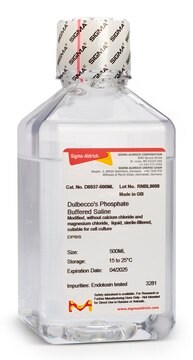The exact number of times the May Grunwald solution can be reused varies depending on factors such as the number of slides stained for each use, temperature, humidity, and exposure to air. Users are expected to evaluate the stain quality for each batch of slides stained and change the solution once the stain quality diminishes. It's important not to return a used working solution back to the stock bottle; instead, used solutions should be stored tightly capped in another bottle, ensuring the cap is always tightly closed to prevent evaporation of methanol and water pickup from the air, which can cause the stain to precipitate out of solution.
MG500
May-Grünwald Stain
About This Item
Productos recomendados
Formulario
solution
caducidad
Expiry date on the label.
DIV
for in vitro diagnostic use
concentración
0.25 % (w/v) in methanol
técnicas
microbe id | staining: suitable
aplicaciones
hematology
histology
temp. de almacenamiento
room temp
¿Está buscando productos similares? Visita Guía de comparación de productos
Descripción general
Aplicación
Nota de preparación
Palabra de señalización
Danger
Frases de peligro
Consejos de prudencia
Clasificaciones de peligro
Acute Tox. 3 Dermal - Acute Tox. 3 Inhalation - Acute Tox. 3 Oral - Flam. Liq. 2 - STOT SE 1
Órganos de actuación
Eyes,Central nervous system
Código de clase de almacenamiento
3 - Flammable liquids
Clase de riesgo para el agua (WGK)
WGK 2
Punto de inflamabilidad (°F)
51.8 °F - closed cup
Punto de inflamabilidad (°C)
11 °C - closed cup
Elija entre una de las versiones más recientes:
¿Ya tiene este producto?
Encuentre la documentación para los productos que ha comprado recientemente en la Biblioteca de documentos.
Contenido relacionado
Learn about the clinical study of blood, blood-forming organs, and blood diseases including the treatment, prevention, and stains and dyes used in hematology testing.
Información sobre los estudios clínicos de la sangre, los órganos hematopoyéticos y las enfermedades sanguíneas, incluidos el tratamiento, la prevención y los tintes y colorantes utilizados en las pruebas hematológicas.
-
how many times the May-Grunwald stain can be reused before it loses its effectiveness in staining.
1 answer-
Helpful?
-
Active Filters
Nuestro equipo de científicos tiene experiencia en todas las áreas de investigación: Ciencias de la vida, Ciencia de los materiales, Síntesis química, Cromatografía, Analítica y muchas otras.
Póngase en contacto con el Servicio técnico










